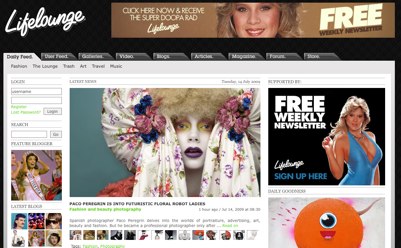
I woke up this morning to see the above graphic as the lead on News.com.au. According to The Australian, “young adults” are switching off and embracing things like vinyl records. The report quotes a study by Lifelounge, a Melbourne based “youth” marketing agency.
Now admittedly the coverage by The Australian is over the top compared to the actual findings, with the article starting with “NEXT thing you know, all the young men will be using Brylcreem, the girls will be in bobby sox and everyone will be learning to jitterbug” when the study actually found that “Australia’s 16-30 year olds are nostalgic for times pre-GFC and climate change when life was perceived as more innocent and uncomplicated.” The GFC started….last year.
The headline of “switching off” is based on the study finding that those surveyed are spending 30 minutes less each week “surfing the internet”… but it’s hardly switching off when you look at the usage numbers: down 30 minutes a week to 8.6 hours (not including chat room and online forums…which are counted separately at 2.5 hours and 1.5 hours each..so total online is 12.6) with the internet still leading TV, PayTV and newspapers (4.4,1.5, 1.9).
But looking past the hyped (and not unexpected take) by The Australian is some rather interesting results.
I’ll go through these point by point.
Starting reference point:
About Urban Market Research: UMR is Australia’s pre-eminent annual trend report into the attitudes and behaviours of the country’s leading young adults (aged 16-30). It contains quantitative (1,662 participants) and qualitative (25 participants) data based on the five lifestyle pillars of youth culture: music, entertainment, fashion, sport and travel, and the key three influences: communication, finance, and sex, health and wellbeing. The research is weighted against ABS statistics and was conducted online between late January and March this year.
Findings:
With 50.2% of young adults living in suburbia with their parents
Really? A survey of those 16-30 found half live with their parents. Lets presume that everyone 16-20 does (16-18 would, then you get the decline from 100%) and we get to 29%. You’d presume that nearly everyone above 25 wouldn’t live with their parents..which leaves 21-24 year olds. 21 is notable because its roughly the age people would finish a three year degree and enter the workforce…presuming they went to Uni. The stat seems high.
The research indicates the GFC has hit the youth market’s collective hip pocket, with total spend across key lifestyle ‘pillars’, music, entertainment, travel, fashion and sport, down more than $5 billion, from $47.5 billion last year to $42.4 billion. The biggest fall was in entertainment, down $7.3 billion to $19.4 billion, while travel spend increased $4.4 billion to $9.3 billion.
I know you can use survey data to come up with these figures, but wouldn’t retail/ commercial data be the better source? Last lot of stats I’ve seen show that GDP is flat and although retail sales have been a bit up and down I don’t recall any massive drops either. Also note that the survey was done in Jan-March. The unemployment rate has only really started to rise in the last few months: so how did it hurt spending so much in January??
The research reveals looking after yourself is in, getting trashed is out. Young adults are taking up jogging, hosting dinner parties and watching home entertainment over going out. They’re expressing themselves through creative pursuits as a source of ‘urban capital’ (ie: what gives them kudos and status among their peers) over their desire to consume.
As much as I believe that the media (and by extension politicians) overplays the so-called drinking issue this country has, likewise there would appear to be an increase in binge drinking as opposed to a significant drop. Let me say as a 33 year old that if I walk into a pub or club on a Friday night I’d likely be one of the oldest people in the room.
“Due to their living circumstances most young adults are yet to feel the direct effect of the global financial crisis, however economic woes and climate change has led them to re-assess what’s important – saving the planet or destroying it through unfettered consumerism,”
Hang on…. I thought the GFC was driving them to spend less..indeed the study already said so, so which is it?
“As digital natives, the youth market has grown up online but are increasingly seeking to balance their online world with offline contact,” Appel said. “They’re starting to question the authenticity of social networks such as Facebook and Twitter. They want technology to assist – rather than dominate – the way they communicate.”
Given Twitter only really took off in a huge way THIS YEAR, how can they reassess something most of them only started using…oh wait, we haven’t got to the sampling issue yet.
(from the Oz article) “Parents’ vinyl records are suddenly interesting and vintage clothes are de rigueur.”
Vinyl? let me check the latest iPod/ iPhone sales figures in Australia…mmm
(from the Oz article, presumably matched by Lifelounge)
Melbourne clothing designer Clea Garrick, 27, said she and her friends had tended to step out of the fast lane over the past year, and were instead enjoying some of the simpler pleasures.
“We’ve definitely had more dinners at our house than we normally would, including a fondue party, would you believe it?” said Ms Garrick, who is married with no children. She agreed there was now a greater emphasis among her peers for human contact rather than online connections than a year ago. “Facebook, for sure, we’ve dropped our usage,” she said. “It’s just a time-commitment issue: how do you want to be spending your time?”
So what they’re describing is maturity…and that’s somehow a trend or something interesting? As “young adults” get older, they slow down and do things like (shock horror) host dinner parties.
The sampling issue
The first thing I went hunting for when I read the story in The Australian is the sampling data; my immediate hunch was that the sample wasn’t representative because it sounds a lot like they surveyed trendy inner-city types, or what Lifelounge describes in its own words the “country’s leading young adults.”
The survey consisted of “quantitative (1,662 participants) and qualitative (25 participants) data…and was conducted online.” They do however say that “The research is weighted against ABS statistics.”
By qualitative (25) you can presume that they actively surveyed people, that is they actually went out and found them. But the Quantitative (1,662) is the interesting one because there’s no details on the form of the poll in the press release, particularly were the participants approached, was it an open poll etc. Their website notes though that the data is gathered “through the development of research and communications channels.”
However Dr Google provided the answer here in about 1 second: the 1,662 Quantitive number consists entirely of readers of the Lifelounge website. Indeed, every year they give away freebies to get people to participate: here’s the post for this years poll. That posts links to the poll itself which you can still do today here.
So just to be clear again: the results are actually representative of readers of the Lifelounge website, which claims to be Australia’s most popular “youth” site with 400,000 uniques a month. So lets take a quick look at what sort of site Lifelounge is

Is that Samantha Fox I see? sure does look like it…how very nostalgic. Oh, and the other word I’d use for Lifelounge (they also do a magazine) is….wait for it….trendy.
I don’t know a lot about Lifelounge outside of their tie-up publishing The Vine with Fairfax and given the numbers I’ve seen for that site, credit where due because they’re doing a great job. However presenting a survey of visitors to your site as being representative of all youth takes a special type of gumption.
Interestingly despite the Fairfax business relationship, as I write this neither The Age or SMH have published the survey results… maybe unlike that pillar of quality journalism News Ltd they understand the nature of surveys and statistics 🙂











